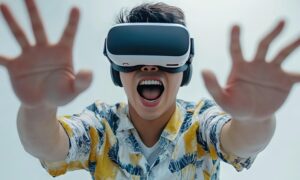Virtual Reality, or VR for short, is a virtual reality system that completely immerses you into an artificial environment that feels real to your brain and allows you to experience anything from a tropical beach or underwater sea adventure all the way up to flight simulations and combat missions.
Virtual Reality has been around since the 1960s but it’s only recently that they’ve become popular with mainstream audiences. This blog post will detail everything you need to know about Virtual Reality so you can better understand what it does and how it works.
What makes Virtual Reality tick?
Virtual reality heavily relies on computer hardware and software working together in order to function properly. As you might imagine since virtual reality simulates an actual environment then there are two main components that make up virtual reality:
– The first component is the virtual environment and it’s simply a computer generated digital world. What this does is allows you to interact with an artificial reality as if it were real, whether that be throwing building blocks around in Minecraft or shooting your friends in Call of Duty.
– The second main component required for Virtual Reality are sensors which track all movement so they can accurately replicate what you’re doing within the virtual environment. This includes motion tracking devices but also head mounted displays (HMDs) such as headsets and glasses since these provide stereoscopic images directly into your eye just like looking down at our phones right now only much more immersive.
What equipment do we need for virtual reality?
What pieces of equipment do we need for this? What will make our VR experience more realistic or unique? Today, we’ll discuss some key hardware components needed in order to create virtual reality experiences! We’ll start from the bottom up: feet first!
– Virtual reality headset (HMD) & motion controller(s)
– Desktop/laptop computer with enough processing power to run your content. In addition, it should have access to at least one USB port on both the front and back of the computer so that you can connect your motion controllers.
What are the Applications of Virtual Reality?
Virtual Reality is a computer-simulated version of reality that allows you to experience anything from anywhere even you can create your own virtual room. It can transport users to different times, places and worlds. What are the Applications of Virtual Reality? Here’s a look at what people have been using VR for:
Education – Schools use virtual tours in classrooms so students could see historical sites or geographic locations without having to leave campus or spend money on field trips. Architects use it to design buildings before they’re even built while construction workers put on headsets in order to collaborate with architects virtually during building projects instead of meeting face-to-face across tables lined with blueprints and models. One college uses VR as an alternative way for professors who aren’t able to teach classes live due to surgeries or sicknesses.
The Gaming and Entertainment Industry – Virtual reality is used in the gaming and entertainment industry to allow users to experience things they otherwise would not. For example, the video game Grand Theft Auto allows players to do what they might never get a chance to try in real life like steal cars and kill people (and police officers). What types of virtual reality are there? There are three main types: visual, auditory, and haptic. Visual means that your eyes perceive images; this type includes watching movies or playing games on devices such as an Oculus Rift headset. Auditory refers only to sound; it’s possible with headphones but also can be achieved by providing sounds through speakers around you. Haptic technology stimulates senses other than sight or hearing using sensors that simulate touch sensations for interaction with computer-generated objects or environments.
Health – In the world of health, VR is used for a range of applications from pain management to PTSD treatment. In one study with burn victims, virtual reality helped distract patients from their pain while doctors treated them, and it was found that patients experienced less stress when they were in this state versus those who weren’t using VR headsets during treatments. Virtual simulations have also been helpful at distracting people experiencing anxiety or phobias as well as helping treat people suffering from post-traumatic stress disorder (PTSD). Researchers are even working on figuring out how VR can help improve outcomes for stroke rehabilitation by measuring how much longer it takes a patient to complete tasks after being given different types of feedback including non-verbal cues through an avatar’s body language as well as verbal instructions over a loudspeaker.
Sports – Athletes from all kinds of sports have been using VR to train and develop their skills for years now, even though it’s still a relatively new technology in the world of athletics. In football, quarterbacks use headsets as an alternative way to practice reading opposing defenses without having real players standing across from them on the field because they can play out defensive scenarios over and over again or view specific parts of plays that might be giving them trouble instead of taking time away from team practices. Other athletes like skiers also rely on virtual reality training programs so they could improve endurance and stamina through simulations before hitting up slopes during competition season while snowboarders use apps with motion-sensing capabilities to create tricks involving flips or rotations that would be too dangerous to perform in real life. Skateboarders, BMX riders, and snowmobiler enthusiasts have also benefitted from using VR training apps on their phones or headsets that allow them to practice tricks before hitting up local skate parks.
The military – Military personnel have begun using similar technology to help them train recruits while they’re still at boot camp before sending them out into combat. Rather than having real weapons and explosives during training, soldiers use VR headsets that recreate realistic scenarios so they can learn how to react properly without getting hurt or hurting their fellow soldiers. This has been helpful for teaching soldiers who might not be familiar with certain kinds of guns or bombs how to respond appropriately under pressure depending on what situation presents itself instead of just shooting aimlessly until something falls over dead as we saw in old war films from decades past.
Virtual tourism – Another application is virtual tourism which lets users explore places they might not otherwise visit in real life without spending a lot of time and money on plane tickets and hotel reservations. This also gives people an opportunity to experience historical events like visiting Pearl Harbor’s memorial site at the USS Arizona Memorial where over 2000 soldiers lost their lives during World War II so they could understand what happened there while walking around thanks to holographic recreations of those tragic events.
Construction – People are also using virtual reality to help them with construction projects so they can test out different designs or building layouts before breaking ground on a project. This has been helpful for the government as well because it allows their engineers and architects to create buildings without having to build prototypes first at great expense which would normally be done through physical mockups made of wood, Styrofoam, or other materials that could take months if not years to produce depending on how big the structure is.
Industrial Design – Virtual reality has been used in the industrial design process to help engineers and product designers develop new products more efficiently by providing them with a virtual space where they can test out different ideas without having to produce any physical prototypes. This however raises some ethical issues especially when it comes to medical devices because if there’s an error or mistake made during digital prototyping, this might not be noticed until after several patients have already undergone surgery using that same faulty equipment which could put lives at risk as well as causing injuries that would need correcting eventually down the line depending on how severe those mistakes were.
Real Estate – Real estate agents are also taking advantage of VR technology so they can show clients houses even before construction is fully complete allowing people to see what their final homes will look like before signing any paperwork to purchase a house or apartment. This has been helpful in the real estate business because it gives people an idea of what they can expect from their new living space without having to wait until everything is finished being built which could take months or even years depending on how much money was spent and how many workers are available for construction at that specific time.
What do these applications have in common? All of them have one thing in common, Virtual Reality.
Startup Related To VR
The Project Holodeck is part of the USC Games program, a joint effort between the Interactive Media Division (IMD) at the USC School of Cinematic Arts (SCA) and the Department of Computer Science at the Viterbi School of Engineering.
Project Holodeck is a virtual reality platform built with consumer-facing technology, DIY off-the-shelf components, cutting-edge custom software, and creatively integrated peripherals. The goal of Project Holodeck is to bring 360-degree full-body virtual reality out of the research lab and into a fun, accessible consumer gaming platform.
According to Vice.com, Project Holodeck aims to bring immersive 360-degree, full-body virtual reality into your living room.



































